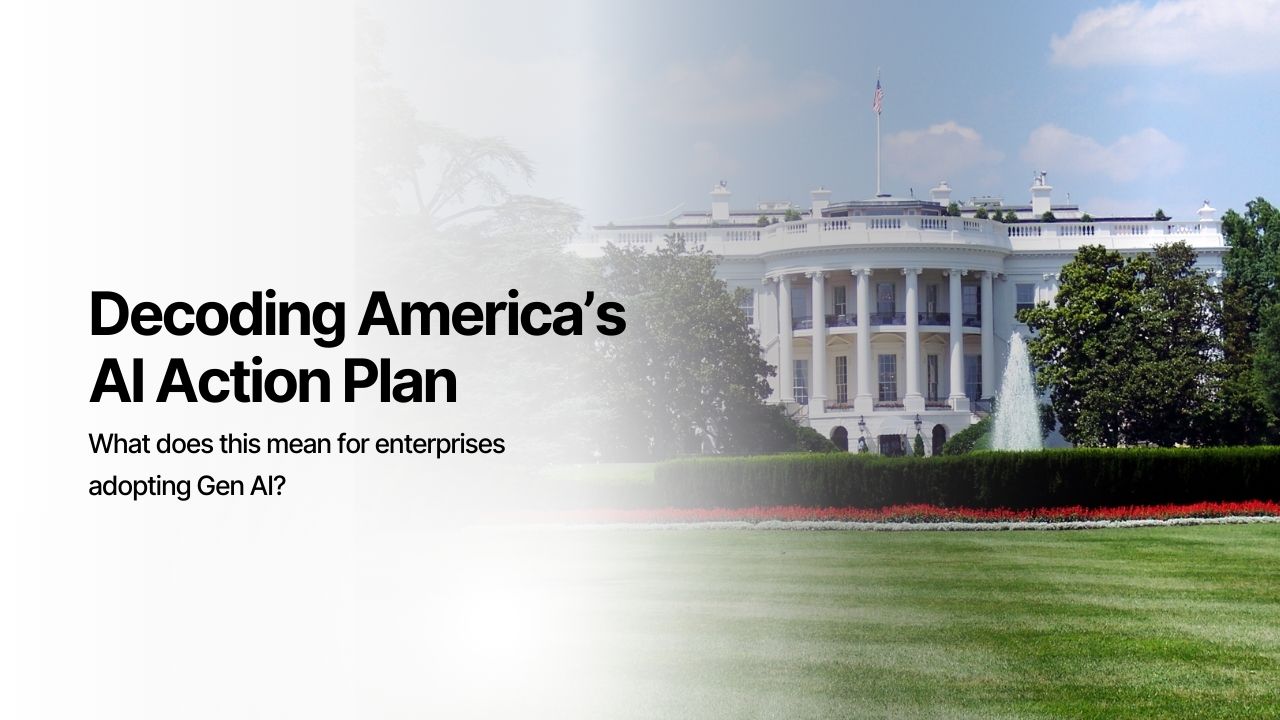60% of enterprises hesitate to scale AI because they are concerned about trust, security, and compliance. If that’s you, you should know what AI guardrails are and what they do.
While Generative AI promises speed, creativity, and automation, it is not without risk, unpredictability, hallucinations, or bias. As AI systems begin to make decisions that affect people’s lives, businesses, and safety, AI guardrails become vital.
AI guardrails are the mechanisms, protocols, and best practices that ensure AI systems behave responsibly, transparently, and predictably. Whether you're building a conversational agent, deploying a decision engine, or automating a workflow, the nature of your AI guardrails determines whether your AI is an asset or a liability.
What are AI guardrails, really?
AI guardrails are a blend of technical controls, ethical constraints, governance policies, and human oversight that ensure models operate within acceptable boundaries. They don’t just limit what AI can do; they define how it should behave and what it cannot help with. Like bumpers in a bowling lane, they don’t stop the ball, they guide it.
AI guardrails must be baked into the entire AI lifecycle, from data collection and model training to real-time response generation and post-deployment monitoring. This makes guardrails not a last-minute safety patch but a foundational element of responsible AI development.
Technical AI guardrails: the 3 Cs
Technical AI guardrails are the foundational safeguards that developers and ML engineers implement to ensure that the AI system behaves reliably and predictably. Primarily, this revolves around the 3 Cs - code, constraints, and controls.
- Input and output constraints: Restricting input prompts and validating outputs using regex, schema checks, or domain rules (such as dosage ranges in medical responses).
- Rate limiting and throttling: Preventing abuse or denial-of-service-style attacks on LLM endpoints.
- Prompt engineering standards: Designing prompts that are repeatable, context-rich, and free from adversarial injection risks.
- Model fencing: Building on platforms like AWS Bedrock ensures additional guardrails to automatically detect toxic, biased, or harmful content.
- Fallback systems: Auto-switching to traditional search, human escalation, or retrieval-augmented responses when LLM confidence is low.
AI content guardrails for quality and accuracy
LLMs are widely used tools. That exposes them to all manner of misuse and plain incorrectness. Content guardrails address issues of truthfulness, tone, appropriateness, and factual reliability. In some contexts, especially legal, medical, or financial, hallucinations may sound intelligent but can carry serious consequences.
AI content guardrails are a form of content moderation with hallucination detection and response validation systems. For example, you can design a system where every generated response is compared against verified sources or passed through secondary models for cross-verification. AI tools often integrate tone and style filters to ensure that responses align with a specific voice, professionalism standards, or user expectations. You may remember the great GPT-4o sycophancy episode from April 2025.
Importantly, content guardrails must also evolve continuously as the use of AI matures. What’s acceptable in a casual chatbot may be wholly inappropriate in a customer service application. AI content guardrails will always be a moving target.
Defining AI guardrails for behavior
A deeply important dimension of AI safety is behavioral design, defining how the AI “acts” in response to complex or sensitive inputs.
Does it remain calm under stress? Does it know when to say “I don’t know”? Behavioral AI guardrails ensure it doesn’t respond emotionally, escalate conflict, or mimic inappropriate prompts. Imagine if an AI assistant just randomly begins to aggravate users.
Well-designed systems refuse to answer unethical or harmful queries. In specific circumstances, we recommend an escalation mechanism to hand over to a human agent. In public applications, AI must also gracefully handle trolling, abuse, or conflicting requests. Behavioral stability is especially important when the AI has a memory or interacts with users over multiple sessions.
Setting behavioral expectations early through prompt tuning, reinforcement learning from human feedback (RLHF), and scenario-based testing ensure that AI behaves not just usefully but ethically and respectfully within enterprise use cases.

AI guardrails for explainability
In domains like finance and healthcare, predictions may well be useless without reasoning. Explainability guardrails ensure model responses are transparent and justifiable.
- SHAP, LIME, and Counterfactuals: To explain how inputs contributed to outputs.
- Natural language explanations: LLMs explaining their logic in human terms.
- Traceable reasoning: In retrieval-augmented generation (RAG), citing sources alongside answers.
- White-box models in critical systems: Systems that are built for humer interpretability.
Explainability builds user confidence, drives adoption, and ensures that potential issues can be troubleshot by following reasoning chains.
Audit trails for AI actions
Auditability is the bedrock of AI governance. AI guardrails ensure that every decision, prompt, or outcome is tracked, versioned, and reviewable.
- Prompt-response logs with timestamps, user IDs, and model versions.
- Model versions and configurations for reproducibility and rollbacks during incidents.
- Human feedback logs to capture user ratings, edits, and override actions.
- Policy violation incident logs that document how they were resolved and who approved overrides.
Human-in-the-loop judgment
Despite rapid advances, AI still lacks human judgment, empathy, and legal accountability. That’s why many applications, especially in sensitive or high-stakes domains, benefit from a Human-in-the-Loop (HITL) architecture where AI serves as a co-pilot, not a pilot
AI copilots can draft, suggest, or pre-screen, but a human makes the final call. In healthcare, for instance, an AI radiology copilot may generate a set of differential diagnoses or a treatment plan, but only a licensed doctor signs off. In finance, you can use AI to detect fraud patterns or evaluate risk profiles, but compliance wonks decide to ignore or act.
Human-in-the-loop frameworks allow enterprises to reap the benefits of AI scale, speed, and pattern detection while ensuring that critical decisions are always anchored in human accountability.
Industry-specific AI guardrails: healthcare and finance
Healthcare
In medical applications, incorrect AI responses can be fatal. Guardrails here include:
- Clinical validation pipelines where all outputs are checked against trusted medical sources (like UpToDate and Mayo Clinic).
- Restricted generation to ensure AI never makes a definitive diagnosis directly to patients and only suggests inferences to clinicians.
- Consent-aware data handling to ensure patient data isn’t leaked or misused.
- Regulatory compliance guardrails that align with HIPAA, FDA, and local health laws.
Finance
Finance involves money, risk, and legality. Guardrails here focus on:
- Risk Controls to flagging speculative or high-risk investment recommendations.
- Data Anonymization during model training and usage.
- Compliance with FINRA, SEC, GDPR, especially chatbots interacting with consumers’ financial data.
- Fairness Audits to ensure credit scoring models don’t discriminate by gender, race, or ZIP code.
AI guardrails for foundational models
The foundation of all AI guardrails is the model itself. Pretrained foundational models like GPT, Claude, Amazon Nova Sonic, or Llama come with baseline safety measures but often need fine-tuning to meet specific domain needs.
Enterprises must choose between open-source models, which offer control but require more engineering, and proprietary models, which come with built-in safety features but less transparency. Multi-model architectures, where smaller specialized models are layered on top of general-purpose LLMs, offer flexibility and scalability, enabling modular guardrails that can be updated independently.
In addition, the modality of your chosen model directly impacts the nature of the AI guardrails needed. For instance, Amazon Nova Sonic is a voice model that natively includes watermarking for the identification of AI-generated content.
“Your chosen model is either your first line of safety or your first point of failure,” says Prashanna Rao, Head of Engineering, GoML. “Consider practices like red-teaming when you build solutions for broad uses that require conversational AI capabilities or for mission critical use cases."
Training and implementation for AI guardrails
Finally, even the best-intentioned AI guardrails will fail if not implemented correctly. Building safe AI requires robust pipelines for training, validation, deployment, and monitoring.
Real-world systems should include synthetic testing to simulate edge cases, red-teaming for adversarial testing, and known failure scenarios. Feedback loops must be active from day one for multi-agent setups, where different agents assume roles such as moderator, summarizer, or critic to cross-check responses in real-time to capture user corrections, flagged outputs, and error rates.
Implementation also involves people: clear internal policies, documentation, and governance frameworks are necessary to operationalize safety. AI guardrails aren’t just code, they’re culture.
At GoML, we specialize in helping enterprises design, build, and scale Gen AI systems with embedded guardrails.
From healthcare safety to compliant finance data pipelines, our boilerplates and engineering rigor ensure that your AI implementation is not just powerful but safe, explainable, and production-ready.
Ready to build safe, scalable, and industry-ready Gen AI systems? Get an executive AI briefing from our experts at GoML






